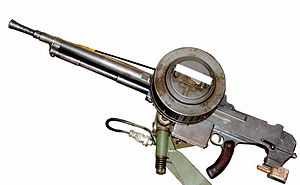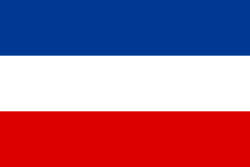Reibel machine gun
| Reibel machine gun | |
|---|---|
 Preserved mitrailleuse mle 31 in the Saumur armour museum | |
| Type | Machine gun |
| Place of origin |
|
| Service history | |
| Used by | See Users |
| Wars |
World War II First Indochina War Algerian War |
| Production history | |
| Designed | 1931 |
| Manufacturer | Manufacture d'armes de Châtellerault |
| Specifications | |
| Weight | 11.8 kg |
| Length | 1.03 m |
|
| |
| Cartridge | 7.5x54 French |
| Caliber | 7.5 mm |
| Action | Gas |
| Rate of fire | 750 rounds per minute |
| Muzzle velocity | 830 m/s (with balle C) |
| Feed system | 150 rounds |
| Sights | Iron |

The Reibel machine gun (official French designation Mitrailleuse mle 1931 - "machine gun, model of 1931"), was a machine gun used on French tanks of the World War II era as well as in fortifications such as the Maginot line.
Overview
The Reibel machine gun is a gas operated weapon chambered in the 7.5 mm MAS cartridge and was loaded with 150-round drum magazines. The variant used in fortifications was specifically modified with a different rifling to accommodate the balle D heavy ball type of ammunition.[1]
Some other guns in French service during late 1940s were converted to ground role, with adoption of the side-mounted 35-roundbox magazines and adapters for US M2 tripods.
The Reibel machine gun is a gas operated weapon which fires from open bolt and in full automatic mode only. It is derived from the French FM 24/29"Fusil-Mitrailleur' also designed by Lt Colonel Reibel. The long stroke gas piston is located below the barrel, and it operates the vertically tilting bolt group. The barrel cannot be removed and replaced in the field. Feed is from multi-layer pan magazines that hold 150 rounds of ammunition (with bullets pointing to the center of the round magazine). Depending on the variant, the magazines can be installed on right or left side of the gun, in vertical plane. Ejection is straight down, through the short chute attached to the base of the receiver. Firing controls include a pistol grip with prominent front-curved shape, and a rifle-type trigger. Normally, a shoulder rest is attached directly to the receiver.
Users
-
.svg.png) Belgium, used on the AMC 35 light tank.
Belgium, used on the AMC 35 light tank. -
 Bulgaria, used on the Hotchkiss H35 light tank.
Bulgaria, used on the Hotchkiss H35 light tank. -
 Republic of China, used on the AMR 35 light tank.
Republic of China, used on the AMR 35 light tank. -
 Croatia, used on the Hotchkiss H35 light tank.
Croatia, used on the Hotchkiss H35 light tank. -
 France, used on the AMR 33 light tanks.
France, used on the AMR 33 light tanks. -
.svg.png) Germany, captured examples.
Germany, captured examples. -
 Hungary, used on the Hotchkiss H35 light tank.
Hungary, used on the Hotchkiss H35 light tank. -
 Israel, used on the Hotchkiss H35 light tank.
Israel, used on the Hotchkiss H35 light tank. -
.svg.png) Italy, used on Renault R35 light tank.
Italy, used on Renault R35 light tank. -
 Lebanon, used on Renault R35 light tank.
Lebanon, used on Renault R35 light tank. -
 Poland, used on Renault R35 light tank.
Poland, used on Renault R35 light tank. -
 Romania, used on Renault R35 light tank.
Romania, used on Renault R35 light tank. -
 Switzerland, used on Renault R35 light tank.
Switzerland, used on Renault R35 light tank. -
 Syria, used on Renault R35 light tank.
Syria, used on Renault R35 light tank. -
 Turkey, used on Renault R35 light tank.
Turkey, used on Renault R35 light tank. -
 Yugoslavia, used on Renault R35 light tank.
Yugoslavia, used on Renault R35 light tank.
Non state groups
- Chetniks, used on the Hotchkiss H35 light tank.
- Yugoslav Partisans, used on the Hotchkiss H35 light tank.
See also
- FM-24/29
- MAC 1934, a faster-firing derivative used aboard aircraft
References
- Ferrard, Stéphane. France 1940 l'armement terrestre, ETAI, 1998, ISBN 2-7268-8380-X